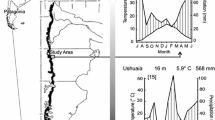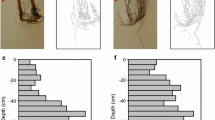Abstract
The range of ecological CSR strategies for subalpine tall-herb communities of the northwestern Caucasus (Teberda state natural biosphere reserve) has been studied by the measurement of leaves’ functional traits. These communities are developed in swales, river valleys, and runoff depressions of the subalpine belt and represent a typical element of the Caucasian flora. The dominating species are represented by tall forbs, such as Rumex alpinus, Senecio platyphylloides, Cephalaria gigantea, Ligusticum alatum, etc. To evaluate ecological strategies of plants, three functional traits, including leaf area and the weights of wet and dry leaves, have been measured. Based on these measurements, the strategy parameters have been calculated for 42 vascular plant species. The majority of plants of the subalpine tall-grass community manifest traits typical for the competitive (C) and competitive-ruderal (CR) strategies. According to the calculation algorithm, 11 species (Angelica purpurascens, A. tatianae, Cirsium chlorocomos, Heracleum asperum, H. leskovii, H. sosnowskyi, etc.) are referred to the C-strategy. The CR strategy is observed for Aconitum nasutum, Cirsium simplex, Geranium sylvaticum, Hesperis voronovii, Rumex alpestris, and some other species. Two species (Achillea millefolium and Dactylis glomerata) are characterized by the competitive and stress-tolerant (CS) strategy. The stress-tolerant (S) strategy is observed for three species (Veronica filiformis, Lilium monadelphum, and Millium effusum). Finally, the mixed CSR strategy is typical for two species (Trifolium pratense and Astrantia maxima). The majority (93%) of the species studied is characterized by clear competitive traits; the contribution of this strategy type positively correlates with the average vegetative height of a species. In addition, many of the studied species (26% on average) are also characterized by some R-strategy traits. In our opinion, this fact results from a long-term grazing history of alpine plant communities in this region. The obtained results contradict the common opinion about the domination of stress-tolerant species in highlands. This contradiction may be explained by the fact that the studied subalpine meadows are located in the most favorable habitats providing competitive advantages for rapidly-growing tall-herb species. The study confirms the hypothesis that the dominated species of the subalpine tall-grass community of the northwest Caucasus are characterized by significantly (up to 95%) manifested traits of C strategy.



Similar content being viewed by others
REFERENCES
Körner, C., Alpine Plant Life: Functional Plant Ecology of High Mountain Ecosystems, Berlin: Springer, 2003.
Grime, J.P., Plant Strategies, Vegetation Processes, and Ecosystem Properties, Chichester: John Wiley & Sons, 2001.
Caccianiga, M., Luzzaro, A., Pierce, S., Ceriani, R.M., and Cerabolini, B., The functional basis of a primary succession resolved by CSR classification, Oikos, 2006, vol. 112, no. 1, pp. 10–20.
Huseyinoglu, R. and Yalcin, E., Competitive, stress-tolerant and ruderal based classification of some plant species in an Alpine community of the Giresun mountains in Turkey, J. Env. Biol., 2017, vol. 38, no. 5, pp. 761–769.
Barba-Escoto, L., Ponce-Mendoza, A., García-Romero, A., and Calvillo-Medina, R.P., Plant community strategies responses to recent eruptions of Popocatépetl volcano, Mexico, J. Veg. Sci., 2019, vol. 30, no. 2, pp. 375–385.
Petriccione, B. and Bricca, A., Thirty years of ecological research at the Gran Sasso d’Italia LTER site: Climate change in action, Nat. Conserv., 2019, vol. 34, no. 1, pp. 9–39.
Pierce, S., Negreiros, D., Cerabolini, B.E., et al., A global method for calculating plant CSR ecological strategies applied across biomes world-wide, Funct. Ecol., 2017, vol. 31, no. 2, pp. 444–457.
Onipchenko, V.G., Alpine Vegetation of the Teberda Reserve, the Northwestern Caucasus, Zurich: Geobotanisches Institut ETH, 2002.
Anten, N.P.R. and Hirose, T., Interspecific differences in above-ground growth patterns result in spatial and temporal partitioning of light among species in a tall-grass meadow, J. Ecol., 1999, vol. 87, no. 4, pp. 583–597.
Michl, T., Dengler, J., and Huck, S., Montane-subalpine tall-herb vegetation (Mulgedio-Aconitetea) in central Europe: Large-scale synthesis and comparison with northern Europe, Phytocoenologia, 2010, vol. 40, nos. 2–3, pp. 117–154.
Pickering, C.M. and Growcock, A.J., Impacts of experimental trampling on tall alpine herbfields and subalpine grasslands in the Australian Alps, J. Environ. Manage., 2009, vol. 91, no. 2, pp. 532–540.
Rehder, H., Nitrogen relations of ruderal communities (Rumicion alpini) in the Northern Calcareous Alps, Oecologia, 1982, vol. 55, no. 1, pp. 120–129.
Grime, J.P., Vegetation classification by reference to strategies, Nature, 1974, vol. 250, no. 5461, pp. 26–31.
Grime, J.P., Evidence for the existence of three primary strategies in plants and its relevance to ecological and evolutionary theory, Am. Natur., 1977, vol. 111, no. 982, pp. 1169–1194.
Grime, J.P., The CSR model of primary plant strategies—origins, implications and tests, in Plant Evolutionary Biology, Dordrecht: Springer, 1988, pp. 371–393.
Pérez-Harguindeguy, N., Díaz, S., Garnier, E., et al., New handbook for standardised measurement of plant functional traits worldwide, Aust. J. Bot., 2013, vol. 61 N, pp. 167–234.
Garnier, E., Navas, M.-L., and Grigulis, K., Plant Functional Diversity: Organism Traits, Community Structure, and Ecosystem Properties, Oxford: Univ. Press, 2016.
Cerabolini, B.E., Brusa, G., Ceriani, R.M., De Andreis, R., Luzzaro, A., and Pierce, S., Can CSR classification be generally applied outside Britain?, Plant Ecol., 2010, vol. 210, no. 2, pp. 253–261.
Pierce, S., Brusa, G., Vagge, I., and Cerabolini, B.E., Allocating CSR plant functional types: The use of leaf economics and size traits to classify woody and herbaceous vascular plants, Funct. Ecol., 2013, vol. 27, no. 4, pp. 1002–1010.
Cornelissen, J.H.C., Lavorel, S., Garnier, E., Diaz, S., Buchmann, N., Gurvich, D.E., Reich, P.B., Steege, H., Morgan, H.D., van der Heijden, M.G.A., Pausas, J.G., and Poorter, H., A handbook of protocols for standardized and easy measurement of plant functional traits worldwide, Aust. J. Bot., 2003, vol. 51, no. 4, pp. 335–380.
Onipchenko, V.G., Zernov, A.S., and Vorob’eva, F.M., Sosudistye rasteniya Teberdinskogo zapovednika (annotirovannyi spisok vidov) (Vascular Plants of the Teberda Nature Reserve (Annotated Species List)), Gubanov, I.A., Eds., Moscow: Maks Press, 2011.
Tappeiner, U. and Cernusca, A., Microclimate and fluxes of water vapour, sensible heat and carbon dioxide in structurally differing subalpine plant communities in the Central Caucasus, Plant Cell Environ., 1996, vol. 19, no. 4, pp. 403–417.
Silva, J.L.A., Souza, A.F., Caliman, A., Voigt, E.L., and Lichston, J.E., Weak whole-plant trait coordination in a seasonally dry South American stressful environment, Ecol. Evol., 2018, vol. 8, no. 1, pp. 4–12.
Wang, J., Zhang, C., Yang, H., Mou, C., Mo, L., and Luo, P., Plant community ecological strategy assembly response to yak grazing in an alpine meadow on the eastern Tibetan Plateau, Land. Degrad. Dev., 2018, vol. 29, no. 9, pp. 2920–2931.
Vittoz, P., Randin, C., Dutoit, A., Bonnet, F., and Hegg, O., Low impact of climate change on subalpine grasslands in the Swiss Northern Alps, Glob. Chang. Biol., 2009, vol. 15, no. 1, pp. 209–220.
Cerabolini, B., Pierce, S., Luzzaro, A., and Ossola, A., Species evenness affects ecosystem processes in situ via diversity in the adaptive strategies of dominant species, Plant Ecol., 2010, vol. 207, no. 2, pp. 333–345.
Funding
The study was supported by the Russian Science Foundation (project no. 19-14-00038).
Author information
Authors and Affiliations
Corresponding author
Ethics declarations
CONFLICT OF INTEREST
The authors declare that they do not have any conflict of interest.
STATEMENT ON THE WELFARE OF ANIMALS
This article does not contain any studies with humans or animals as the objects of studies.
Additional information
Translated by N. Statsyuk
About this article
Cite this article
Dudova, K.V., Dzhatdoeva, T.M., Dudov, S.V. et al. Competitive Strategy of Subalpine Tall-Grass Species of the Northwestern Caucasus. Moscow Univ. Biol.Sci. Bull. 74, 140–146 (2019). https://doi.org/10.3103/S0096392519030039
Received:
Revised:
Accepted:
Published:
Issue Date:
DOI: https://doi.org/10.3103/S0096392519030039




